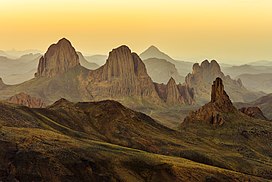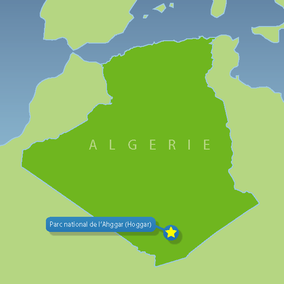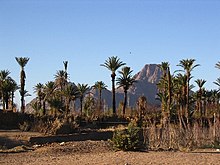Hoggar Mountains
| Hoggar Mountains | |
|---|---|
 Landscape of the Assekrem region in the Hoggar in Tamanrasset Province | |
| Highest point | |
| Peak | Mount Tahat |
| Elevation | 2,908 m (9,541 ft) |
| Coordinates | 23°17′20″N 05°32′01″E / 23.28889°N 5.53361°E |
| Naming | |
| Native name |
|
| Geography | |
| Country | Algeria |
| Hoggar National Park | |
|---|---|
 Locator map | |
| Location | Tamanrasset Province, Algeria |
| Nearest city | Tamanrasset |
| Coordinates | 22°08′N 6°10′E / 22.133°N 6.167°E |
| Area | 450,000 km2 (170,000 sq mi) |
| Established | 1987 |
 | |
The Hoggar Mountains (Arabic: جبال هقار, Berber: idurar n Ahaggar) are a highland region in the central Sahara in southern Algeria, along the Tropic of Cancer. The mountains cover an area of approximately 550,000 km2.[1]
The Hoggar Mountains are home to the Ahaggar National Park, one of the national parks of the country.[2] The tallest peak in the range and Algeria, Mount Tahat, is located in the park area, which covers approximately 450,000 square kilometres (170,000 sq mi).[2]
Geography[edit]


This mountainous region is located about 1,500 km (930 mi) south of the capital, Algiers. The area is largely rocky desert with an average elevation of more than 900 m (3,000 ft) above sea level. The highest peak, Mount Tahat, is at 2,908 m (9,541 ft).[1] The mountains are primarily composed of metamorphic rock approximately 2 billion years old, although there are areas where more recent volcanic activity has laid down much newer rock.[1] Several of the more dramatic peaks, such as Ilamen, are the result of erosion wearing away extinct volcano domes, leaving behind the more resistant material that plugged the volcanic cones.[1]

Assekrem is a famous and often visited point where Charles de Foucauld built a hermitage in 1911.[3]
The highlands are believed to be one of the main sources of the Tamanrasset River, an ancient river that flowed during the African humid period, and named after the main city near the Hoggar Mountains, Tamanrasset, built in a desert valley or wadi that was part of the ancient watercourse.
Environment[edit]
The Hoggar Mountains range typically experiences hot summers, with a cold winter climate. Temperatures fall below freezing in the winter. Rainfall is rare and sporadic year-round. However, since the climate is less extreme than in most other areas of the Sahara, the mountains are a major location for biodiversity, including a number of relict species. The Hoggar Mountains are part of the West Saharan montane xeric woodlands ecoregion.
Fauna and flora[edit]
Slightly to the west of the Hoggar range, a population of the endangered African wild dog (Lycaon pictus) remained viable into the 20th century, but is now thought to be extirpated within this entire region.[4]
Analysis of collected scat in 2006 showed the presence of the Northwest African cheetah in the region.[5][6] Between August 2008 and November 2010, four individuals were recorded by camera traps.[7] A single cheetah was filmed and photographed by Algerian naturalists in 2020 in the national park in the Atakor volcanic field whose peaks approach a height of 3,000 metres (9,800 ft).[8]
Relict populations of the West African crocodile persisted in the Hoggar Mountains until the early 20th century.[9]
The park also contains a population of herbivores such as the saharan subspecies of the barbary sheep and the Dorcas gazelle.[2]
Vegetation in this area includes trees such as Vachellia tortilis, Vachellia seyal, myrtle and Tamarix aphylla which are scattered throughout the area. Other plants may include Citrullus colocynthis and Calotropis procera.
History[edit]
Prehistoric settlement is evident from extant rock paintings dating to 6000 BC.[10] The Hoggar Massif is the land of the Kel Ahaggar Tuareg.[1] The tomb of Tin Hinan, the woman believed to be the matriarch of the Tuareg, is located at Abalessa, an oasis near Tamanrasset.
The hermitage of Charles de Foucauld, which continues to be inhabited by a few Catholic monks, is at the top of the Assekrem plateau in the Hoggar Mountains.[11]
Underground atomic tests were conducted by France in the mountains in the 1960s.
Panoramic view[edit]
See also[edit]
References[edit]
- ^ a b c d e Scheffel, Richard L.; Wernet, Susan J., eds. (1980). Natural Wonders of the World. United States of America: Reader's Digest Association, Inc. pp. 32–33. ISBN 0-89577-087-3.
- ^ a b c "Ahaggar National Park, Saharan Algeria Region, Algeria". Algeria.com. Retrieved 27 May 2020.
- ^ Sattin, Anthony Ham, Nana Luckham, Anthony (2007). Algeria (1st ed.). Footscray, Vic.: Lonely Planet. p. 188. ISBN 978-1741790993.
assekrem.
{{cite book}}: CS1 maint: multiple names: authors list (link) - ^ Hogan, C. Michael (2009). "Painted Hunting Dog: Lycaon pictus". GlobalTwitcher.com. N. Stromberg. Archived from the original on December 9, 2010.
- ^ Busby, G. B. J. (2006). The Cheetah (Acinonyx jubatus) in Northern Africa : A Non-Invasive Genetic Study of Carnivores from the Ahaggar Mountains, Southern Algeria (PDF) (Master's thesis). Imperial College London. Archived from the original (PDF) on 2020-09-21. Retrieved 2010-09-22.
- ^ Busby, G. B. J.; Gottelli, D.; Durant, S.; et al. (November 2006). "A Report from the Sahelo Saharan Interest Group - Office du Parc National de l'Ahaggar Survey, Algeria (March 2005) - Part 5: Using Molecular Genetics to study the Presence of Endangered Carnivores" (PDF). Unpublished Report. Archived from the original (PDF) on 2016-03-04. Retrieved 2010-09-22.
- ^ Belbachir, F.; Pettorelli, N.; Wacher, T.; Belbachir-Bazi, A. & Durant, S.M. (2015). "Monitoring rarity: the critically endangered Saharan cheetah as a flagship species for a threatened ecosystem". PLOS ONE. 10 (1): e0115136. Bibcode:2015PLoSO..1015136B. doi:10.1371/journal.pone.0115136. PMC 4309643. PMID 25629400.
- ^ Agence France-Presse (24 May 2020). "Critically Endangered Saharan Cheetah Seen in Algeria For The First Time in a Decade". Sciencealert.com. Retrieved 27 May 2020.
- ^ Brito, J. C.; Martínez-Freiría, F.; Sierra, P.; et al. (2011). "Crocodiles in the Sahara Desert: An Update of Distribution, Habitats and Population Status for Conservation Planning in Mauritania". PLOS One. 6 (2): e14734. Bibcode:2011PLoSO...614734B. CiteSeerX 10.1.1.293.4325. doi:10.1371/journal.pone.0014734. PMC 3045445. PMID 21364897.
- ^ Haggett, Peter (2001). Encyclopedia of World Geography. Marshall Cavendish. ISBN 0-7614-7289-4.
- ^ Ham, Anthony (2007). Algeria. Lonely Planet. p. 188.
Further reading[edit]
- Keenan, Jeremy (1977). The Tuareg: People of Ahaggar. London: Allen Lane, Penguin Books. ISBN 0-7139-0636-7.


